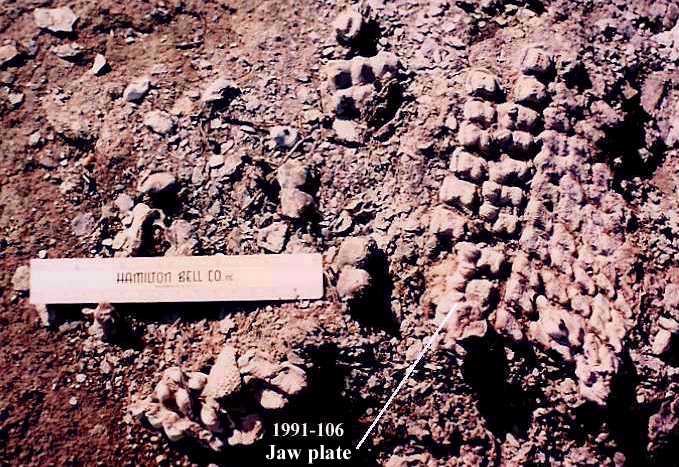 |
Ptychodus mortoni
A shell-crushing shark from the Late Cretaceous of
western Kansas.
Copyright © 2000-2013 by Mike Everhart
Last updated 11/18/2013
LEFT: FHSM VP-14785 -
an upside down upper Ptychodus
mortoni jaw plate as found, Smoky Hill Chalk, Gove County, Kansas. |
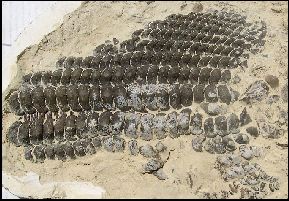 |
Ptychodus is a genus of durophagous (shell-crushing)
sharks from the Late Cretaceous. Their teeth are often found as fossils around the
world. They are also fairly common occurrences in the sediments deposited in the Western Interior Sea of North America.
They became extinct in the Western Interior Sea during the Santonian, about 85 million years ago. LEFT
and RIGHT: Associated upper and lower jaw plates of Ptychodus mortoni collected
from Hell Creek, near the middle of the Smoky Hill Chalk in southern Gove
County, Kansas, and prepared by Dennis Olson. |
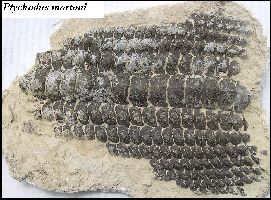 |
The History of the discovery and naming of Ptychodus
mortoni
When Ptychodus
remains were first discovered in England, they were generally recognized as
being the “palates of fish.” One of the first references that I can find, pages
408-409 in Urban, S. (ed., August, 1755) mentions
"specimens
of fossil palates of fishes, collected from under the northern cliffs of Shepey
Island.” The illustrations
accompanying the note do not appear to represent
Ptychodus teeth, but the terminology seems to begin about that
time. Bright,
(1817) in describing the geology near Bristol, England, wrote
“16. A thin bed of limestone breccia containing rounded pebbles, and organized
substances resembling palates of fish.” Conybeare
and Phillips (1822) describe the “Vertebrae of fish, Sharks teeth, and many
singular palatal tritores, and the radius of a Balistes, exhibit proofs of the
existence of vertebral animals in this formation.”
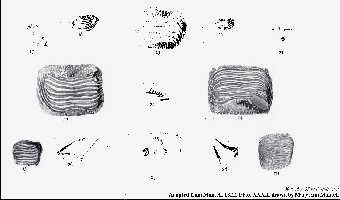 |
LEFT: Some of the first illustrations of Ptychodus
teeth (as yet unnamed at the time) was in Mantell (1822). On page 231,
Mantell remarked, “But the fossil teeth
are sometimes found in considerable numbers, and of various sizes,
forming a tesselated surface of
several square inches; and so regularly disposed, the smaller palates
being adapted to the intervals between the larger ones, that no doubt can
exist of this having been the mode in which they were placed in the
original. Hence, instead of each specimen being. a distinct palate, like
the corresponding teeth of the Diodon, they appear to have
constituted the covering of the entire roof and base of the mouth.
These teeth are termed by Mr. Miller, dentes tritores: "they
differ from the molares, in not being affixed to the jaws." He
supposes them "to have been
attached to the palate
bones, os hyoides, &c. of fish of the genera Diodon, and
Balistes. It was their office to crush the food, fishes generally
having teeth of detention in their maxillæ."
Mantell (1829, page 207) wrote “the palates resemble those of Diodon
Histrix; but from the numbers often found grouped together, the mouth
of the original appears to have been paved with them.”
|
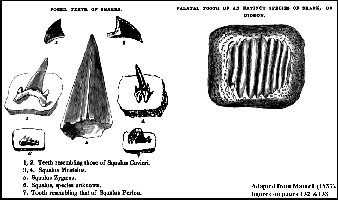 |
LEFT: Mantell (1833): The
fossil palate teeth have hitherto been considered as belonging to a fish
related to the Diodon; they are more or less of a quadrangular shape,
having the outer surface convex, and composed of an exceedingly hard
enamel, which in the centre is formed into sharp and slightly curved
ridges; these are surrounded by a border of obtuse papillae. The Diodon
histrix has one tooth of this kind affixed to the os hyoides, and
another to the palate or roof of the mouth. But the fossil teeth are
sometimes found in considerable numbers, and of various sizes, forming a
tesselated surface of several square inches; and so regularly disposed,
the smaller palates being adapted to the intervals between the larger
ones, that no doubt can exist of this having been the mode in which they
were placed in the original. Hence, instead of each specimen being a
distinct palate, like the corresponding teeth of the Diodon, they appear
to have constituted the covering of the entire roof and base of the mouth.
|
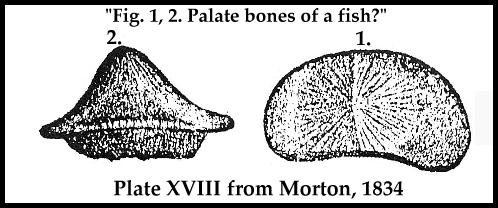 |
Morton (1834, p. 30) wrote: "In the Academy of Natural Sciences, and in
private collections in this city, are some interesting remains which
appear to
have belonged to Saurian animals. I possess some singular specimens
figured on pl. xviii., figs. 1 and 2. At first I supposed them to be
dermal bones, allied to those of the Hylæosaurus,
as figured by Mr. Mantell; but as they possess a distinct enamel, and as
some specimens are worn by attrition on the apex, they may have been the palate
bones of some marine animal."
LEFT: The first illustration of a Ptychodus mortoni tooth was
published by Morton (1834) but was not further identified in the caption other than "The palate bones of a
Fish?"
More
here on Ptychodus from the English Chalk
|
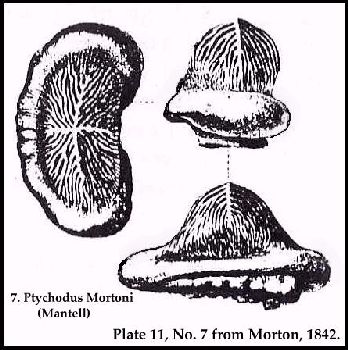 |
The same specimen was later sent to Dr. Mantell in England for
identification. It was subsequently named by Mantell - "I have named it
Ptychodus Mortoni" (1836, p. 27). The
specimen is now in the British Museum of Natural History (Mantell
Collection - BMNH 28394)
According to Morton (1842, p. 215), the first tooth of Ptychodus mortoni was
found by "Mr. Conrad in the older cretaceous strata at Prairie Bluff, Alabama."
(Manning, Pers. comm, 2002) indicated that is more likely that the tooth was from the
Mooreville Chalk near Erie, Alabama). Morton also noted that “I
subsequently sent specimens of them to my distinguished friend, Dr.
Mantell, who returned me three beautiful drawings (which are accurately
copied on the annexed plate), with the name Ptychodus Mortoni
appended. Dr. Mantell, however, has not informed my in what work the
description is published.”
Mantell apparently sent Agassiz’s drawing to Morton without
informing Morton of his 1836 publication, or the source of the drawings.
LEFT: A draft version of Agassiz's Ptychodus mortoni figures
published by Morton in 1842.
However, the specimen was not described by Agassiz until
March 1843, on page 157). The original description by Agassiz is shown below. Roughly translated, Agassiz wrote: “I
saw in the collection of Mr. Mantell a very similar tooth in form to those of Ptychodus
in general but in which differs by the provision of the folds of its surface. Instead of
large simple transverse wrinkles, the crown presents large ramified folds being born from
the most projecting part of the tooth (fig. 3), and attenuating imperceptibly towards the
horizontal pad which separates the crown from the root (fig. 1 and 2). Having seen up to
now only one tooth of this species, I cannot affirm if the provision of its folds, the
height of its crown and the width of its base are specific characters, or if these details
vary in different positions in the mouth. This tooth comes from the green sand of the United
States, and was communicated to Mr. Mantell by Doctor Morton.”
|
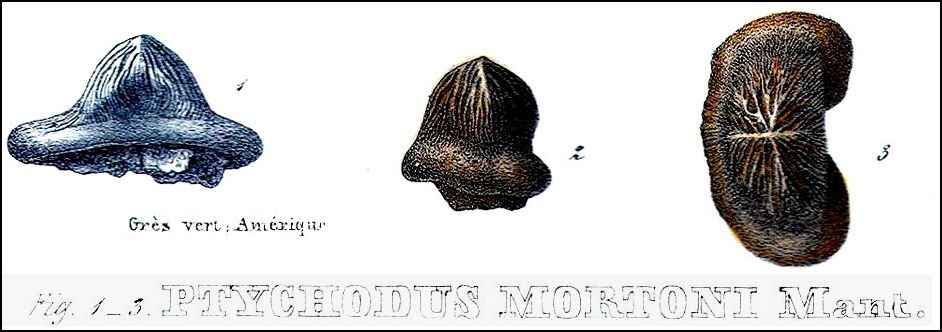 |
VI.
PTYCHODUS
MORTONI
Ag.
Vol. 3, Tab. 25, fig. 1, 2 et
3.
"
J’ai vu dans la collection de M.
Mantell une dent très-semblable, par sa
forme, à celles des Ptychodus en général
mais qui en deffère par la disposition des plis de sa surface. Au lieu de grosses rides tranversales simples, la couronne
présente de gros plis ramifiés, naissant de la partie la plus saillante de
la dent fig. 3, et s’atténuant insensiblement
vers le bourrelet horizontal qui sépare la
couronne de la ricine, fig. 1 et 2. N’ayant vu jusqu’ici qu’une seule dent de cette espèce, je
ne puis affirmer si la disposition de ses plis, la hauteur
de sa couronne et la largeur
de sa base sont des caractères spécifiques, ou si
ces détails varient sur différens points de la gueule.
Cette dent provient du
grès vert des États-Unis, et a été communiquée a M.
Mantell par le docteur Morton."
LEFT: The color
plate was published by Agassiz (1839, Tome
III, Tab. 25, Figs 1–3) in color. |
 |
In a note on Ptychodus (1873 p. 295), Leidy wrote, "The
extinct genus of cestraciont fishes above named was inferred by Agassiz, from isolated
teeth, the only parts yet found which can be with any certainty referred to the same
animal. A number of species have been indicated, mostly by the same authority, from the
specimens found in the Cretaceous formations of Europe and America." Teeth
of Ptychodus Mortoni have been discovered in the Cretaceous deposits of Alabama,
Mississippi, and Kansas, but I have seen none from the corresponding formation of New
Jersey or elsewhere. "
LEFT: Jean Louis Rudolph Agassiz (1807-1873)
- Swiss born
scientist and paleontologist and one of the founders of the Museum of Comparative Zoology at Harvard, Agassiz
described and named most of the species of fossil sharks that we are familiar with today.
(Agassiz, J. L. R. 1833-1844. Recherches sur les Poissons Fossiles. 3: pp. vii + 390 + 32,
Neuchàtel and Soleure) |
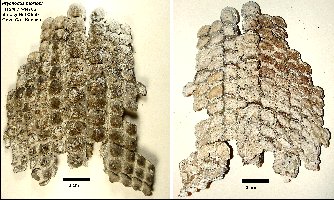 |
LEFT: I was fortunate enough to find an articulated specimen of
this species of "shell-crushing" shark (Ptychodus mortoni) while collecting
mosasaur remains in December of 1991 in Gove County, Kansas. It consists of more than 100
(mostly) articulated teeth. As shown at the top of the page, the upper jaw was lying on the surface
of the chalk, crown-side down when discovered. The specimen was in the process of
coming apart as it eroded out. The jaw plate was found between Hattin's (1982)
Marker Unit 4 and Marker Unit 5, and are late Coniacian in age (about 86 mya). This
specimen was been donated (2002) to the Sternberg Museum of Natural History and is curated
as FHSM VP-14785. The specimen is fully described in Shimada 2012. |
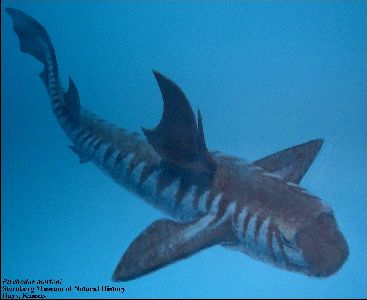 |
LEFT: An artist's conception of what Ptychodus
mortoni may have looked like... based on the modern Port
Jackson Shark (Heterodontus -See Systematic Paleontology
section below). This painting is part of a mural at
the Sternberg Museum of Natural
History in Hays, Kansas. More recent work appears to indicate that it
was more like a lamniform shark in body shape.. |
Ptychodus mortoni is one of five ptychodontid species documented from
the Smoky Hill Chalk Member of the Niobrara Chalk Formation (P.
anonymous (now P. rugosus per Hamm, 2010), P. latissimus, P. polygyrus and P. martini are the other
four). From the number of single teeth and other remains that have been found, P.
mortoni apparently was the most common species at this time, and probably the last species of Ptychodus
to be found in the Western Interior Sea. P. mortoni became extinct in the
Western Interior Sea about the 85 million years ago in the middle Santonian. No one is quite sure what they looked like, but from
the shark-like vertebrae associated with several specimens, it appears that they may have
been more shark-like in body form than ray-like. Judging from the size of some isolated
teeth and this specimen of 539 associated teeth (KUVP
55270) in the University of Kansas Museum of Natural History collection, these fish
probably grew to lengths of 4-5 meters (See Shimada, et al. 2010 for an even
larger estimate). Here are some representative (and very worn) teeth
from a specimen in the Sternberg Museum of Natural History that includes over 870 teeth (FHSM VP-335).
Dr. G.M. Sternberg and Professor B.F. Mudge) were among the first to collect Ptychodus
teeth from the Smoky Hill Chalk. Mudge's contribution was acknowledged by Cope
(1874) while Sternberg was credited by Leidy (1873), including several specimens that he
illustrated. In regard to the Ptychodus mortoni teeth, Leidy noted that.
"The Smithsonian Institution has submitted to my examination a collection of fourteen
specimens of teeth obtained by Dr. George M. Sternberg, United States Army, from the banks
of Chalk Bluff Creek, a branch of Smoky Hill River, about sixty miles east of Fort
Wallace, Kansas. The specimens were found in two parcels, each together, as if pertaining
to two individuals." The figures published by Leidy are shown below:
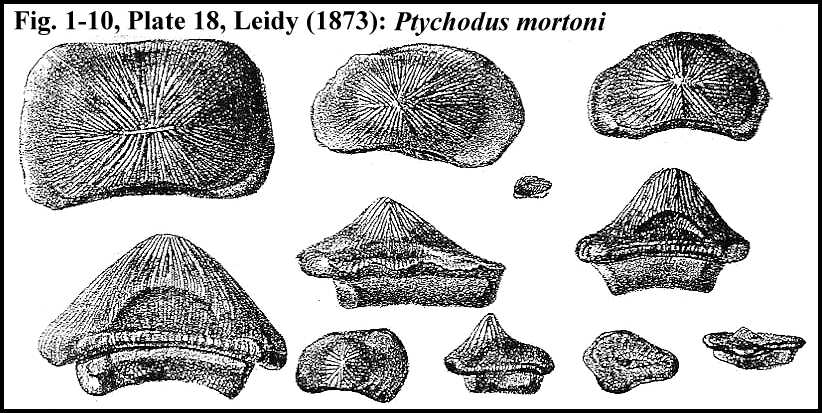 |
Ptychodus mortoni Agassiz 1836, from two individuals,
collected by Dr. George M. Sternberg in 1867. Leidy, Joseph, 1873.
Contributions to the extinct vertebrate fauna of the western interior territories. Rept.,
U.S. Geol. Surv. Terr. (Hayden) 1:358 pp., 37 pls. |
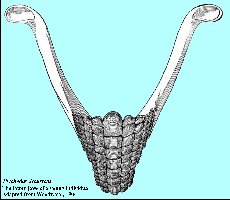 |
LEFT: A reconstruction of the lower jaws (Meckel's
cartilages) of a young Ptychodus
decurrens specimen from the English Chalk by A.S. Woodward
(1904). |
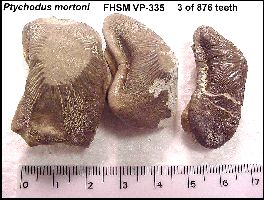 |
LEFT: Three of 876 Ptychodus mortoni teeth from a single
specimen (FHSM VP-335). Collected from Hells Bar Canyon in southwest Gove County in 1952.
Note the wear facet on the large tooth at far left. RIGHT:
Three of 112 teeth of a single specimen of Ptychodus mortoni (FHSM VP-336) from
the same locality as above. This locality represents the last occurrence of Ptychodus
in the Smoky Hill Chalk (Just below Hattin's Marker Unit 10, Middle Santonian). |
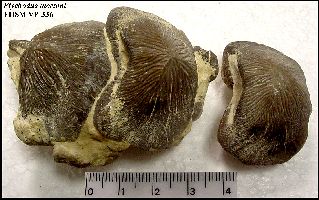 |
Below are pictures of the Ptychodus mortoni specimen (FHSM VP-14785)
that I collected and donated to the Sternberg Museum of Natural History:
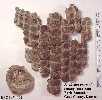 |
Crown view of the FHSM VP-14785 Ptychodus mortoni tooth
sets (old EPC 1991-106). The round object at the lower left
is a small Platyceramus sp. shell that
is probably within the size range of prey preferred by ptychodontid sharks.
Here is a view of a partial tooth plate in
the Sternberg Museum of Natural History (FHSM VP-2238).
Note that this picture shows the probably full width of the jaw plate sets. The
anterior and posterior portions are missing.
|
 |
Root view of the above specimen. Note the row of small symphysial
teeth between the two medial tooth rows. Ptychodus teeth are found at the
same stratigraphic levels as compacted masses of crushed,
very thin (less than .3 mm) Inoceramid shells..... Are these Ptychodus
coprolites?... I think so. It is more likely that even the larger ptychodontid
sharks preferred the small, thin-shelled juvenile inoceramids to the much larger, thicker
shelled adults. |
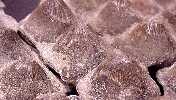 |
A close-up of several of the teeth in one of the FHSM VP-14785
tooth sets, showing wear on the apex of each tooth that might be expected if they were
used to crush hard objects. |
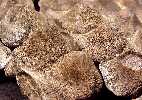 |
Another close-up, from an angle. |
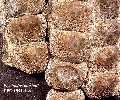 |
Another close-up. Note that, unlike most Ptychodus
teeth, the ridges radiate from a center point in Ptychodus mortoni, not like the
parallel ridges in P. anonymus or P. martini. |
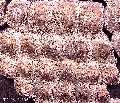 |
A picture of 20 articulated teeth near the center of the FHSM
VP-14785 specimen. |
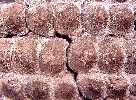 |
A view of the medial rows of teeth, showing portions
of the tops of the
symphysial teeth (small teeth between the larger top and middle rows). |
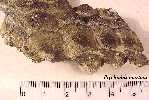 |
One of the unusual features of this specimen is the 'roll-over' of
teeth at the back of the right side of the jaw plate... In the case of Ptychodus,
the new teeth were
formed under the back of the jaw plate and moved over the edge as the
roots were added. There are five teeth in the process of being
formed under the jaw plate in this area. |
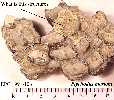 |
This is a picture of the lower or root side of the jaw plate,
showing the incomplete root of a single forming (bud) tooth that had been preserved
below the
articulated teeth in the tooth plate. |
SYSTEMATIC PALEONTOLOGY
Class Chondrichthyes
Huxley, 1880
Subclass Elasmobranchii
Bonaparte, 1838
Cohort Euselachii Hay, 1902
Subcohort Neoselachii
Compagno 1977
Order incertae sedis
Family Ptychodontidae
Jaekel, 1898
Genus Ptychodus
Agassiz, 1835
Ptychodus mortoni Agassiz
1836 |
"Woodward
(1887, p. 128) noted that the dentition of Ptychodus “is that of a true Ray,
and does not bear the slightest resemblance to that of the Cestraciont Sharks.” While
the Family Ptychodontidae has more recently been included in the Superfamily Hybodontoidea
Zangerl, 1981 (Cappetta, 1987; Welton and Farish, 1993, and others), Stewart (1980)
suggested that “…that all living sharks and rays (including Heterodontus)
are members of the monophyletic Neoselachii, united by synapomorphies including the
presence of calcified centra. Since Ptychodus shares this derived state, it must be
regarded as a neoselachian and not as a hybodont …” Stewart’s conclusion
was based on calcified centra found in a relatively complete specimen Ptychodus mortoni
which is now in the University of Kansas collection (KUVP 59041). Cappetta (1987, p. 37)
acknowledged Stewart’s comments, but noted that “it cannot be excluded that
calcified centra appeared parallely in very specialized hybodonts like Ptychodus.”
Unfortunately, KUVP 59041 has not been described further. Stewart’s (1980) suggestion
is followed here while the authors note that additional refinement is necessary regarding
the placement of the Family Ptychodontidae within the Neoselachii." (From Everhart
and Caggiano 2004) |
A recent discovery..................On June 1, 2003, while we were surveying
a new locality, my wife (Pam) found another Ptychodus mortoni specimen coming
out from under a small bush. The specimen was donated to the Sternberg Museum and is
curated as FHSM VP-15532.
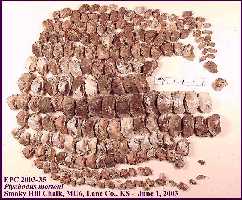 |
We could see about 20 teeth lying on the surface, some of which
were obviously scattered away from the main area. It had rained recently and it was
apparent that a lot of water and surface debris had flowed across the specimen. I
picked up about 10 teeth in a small gully below the place where the teeth had eroded out,
and looked around to see if there were any more. Once I had bagged the loose teeth, I
began to try to locate the source. I soon found that most of the teeth were still in the
chalk. The count was up to about 150 by the time I finished digging around the bush. I
collected the matrix and then water-washed it after we returned home. There were
about 55 more teeth still in the matrix, mostly very small laterals , giving a total count
of about 205 for this specimen. |
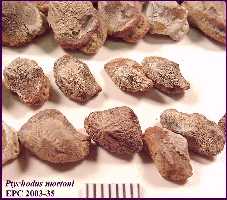 |
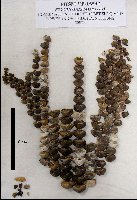 |
LEFT: A 2009 reconstruction of the VP-15532 jaw plate by
Shawn Hamm. It turned out to portions of both the upper and lower
jaws.
RIGHT: A new (2010) upper jaw plate from the Smoky Hill Chalk of
Logan County, KS. This specimen (FHSM VP-17606), discovered by Steve Mense, included more
than 550 teeth, pieces of the upper jaw (palatoquadrate), two vertebrae,
and hundreds of tiny dermal and oral denticles. The jaw plate, as
reconstructed at right, measures 20 inches wide by 22 inches long, but
would have been somewhat smaller in life.
|
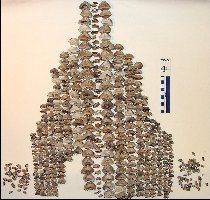 |
Suggested references on Ptychodus in Kansas and around the world:
Agassiz. L. 1835. Feuilleton additionel sur les
Recherches sur les Poissons fossiles.
Agassiz,
L. 1836. Recherches sur les Poissons
Fossiles. 3: pp. vii + 390 + 32, Neuchàtel.
Applegate, S. P. 1970. The
vertebrate fauna of the Selma Formation of Alabama; Part VIII, The Fishes. Fieldiana
Geology Memoirs 3(8):383-433, text figs. 174-204.
Bright,
R. 1817. VIII. On the Strata in the Neighourhood of Bristol. Transactions of the
Geological Society 4:193-205. (Read 15 November, 1811).
Cappetta, H.
1973. Selachians from the Carlile Shale (Turonian) of South Dakota. Journal of
Paleontology 47(3):504-514.
Cappetta, H. 1987. Chondrichthyes II - Mesozoic and Cenozoic
Elasmobranchii. Gustav Fischer Verlag, Stuttgart and New York. 193 p., 148 fig.
Case, G. R. and D. R. Schwimmer. 1988. Late Cretaceous fish from
the Blufftown Formation (Campanian) in western Georgia. Journal of Paleontology
62(2):290-301.
Case, G. R., T. T. Tokaryk and D.
Baird. 1990. Selachians from the Niobrara Formation of the Upper
Cretaceous (Coniacian) of Carrot River, Saskatchewan, Canada. Canadian
Journal of Earth Sciences 27:1084-1094.
ON LINE: Cicimurri, D. 2001. Cretaceous
elasmobranchs of the Greenhorn Formation (Middle Cenomanian-Middle Turonian), western
South Dakota. p. 27-43 in V. L. Santucci and L. McClelland (eds.), Proceedings
of the Sixth Fossil Resource Conference, Geologic Resources Division Technical Report,
NPS/NRGRD/GRDTR-01/01.
Cicimurri, D. J. 2004. Late Cretaceous
chondrichthyans from the Carlile Shale (Middle Turonian to Early Coniacian) of the Black
Hills region, South Dakota and Wyoming. The Mountain Geologist 41(1):1-16.
Conybeare,
W.D. and Phillips, W. 1822. Outlines of the Geology of England and Wales. Book
III, Chapter I. Section IV. Carboniferious or Mountain Limestone. Page 356
Cope, E. D. 1874.
Review of the Vertebrata of the Cretaceous period found west of the Mississippi River. U.
S. Geological and Geographical Survey of the Territories, Bulletin 1(2):3-48.
Cope, E. D. 1875. The
Vertebrata of the Cretaceous formations of the West. Report of the U. S. Geological Survey
of the Territories (Hayden). 2:302 pp., 57 pls.
David, M.L. 1996. Dental histology of Ptychodus and its implications in the
phylogeny of the Ptychodontidae, Journal of Vertebrate Paleontology 16(suppl. to 3):30A.
David, M.L. 1999. A histological and
mechanical description of Ptychodus. M.S. thesis, Fort Hays State
University, Hays, Kansas, 44 pp.
DeKay, J.E. 1842. Zoology
of New York; or, The New York Fauna. Part IV, Fishes, 415 pp, Pl. LXXIX,
(Ptychodus mortoni Mantell, p. 386)
Dibley, G. E.
1911. On the teeth of Ptychodus and their distribution the English Chalk.
Quarterly Journal of the Geological Society of London 67:263-277, pls. 17-22.
Dixon,
F. 1850. The geology and fossils of the Tertiary and Cretaceous formations of
Sussex.
Everhart, M. J.
2003. First records of plesiosaurs from the lower Smoky Hill Chalk Member (Upper Coniacian) of the Niobrara Formation of western Kansas.
Kansas Academy
of Science, Transactions
106(3-4):139-148.
Everhart, M.J. 2013.The
Palate Bones of a Fish?” – The First Specimen of Ptychodus mortoni (Chondrichthyes;
Elasmobranchii) from Alabama. Bulletin of the Alabama Museum of Natural
History 31(1):98-104.
Everhart, M. J. and Caggiano, T.
2004. An associated dentition and calcified vertebral centra of the Late Cretaceous
elasmobranch, Ptychodus anonymus Williston 1900. Paludicola 4(4), p. 125-136.
Everhart, M. J., T. Caggiano, and K. Shimada. 2003. Note on
the occurrence of five species of ptychodontid sharks from a single locality in the Smoky
Hill Chalk (Late Cretaceous) of western Kansas. (Abstract) Kansas Academy of Science,
Transactions 22:29.
Everhart, M. J. and Darnell. M.K. 2004.
Occurrence of Ptychodus mammillaris (Elasmobranchii) in the Fairport
Chalk Member of the Carlile Shale (Upper Cretaceous) of Ellis County, Kansas.
Kansas Academy of Science, Transactions 107(3-4):126-130.
Evetts, M. J. 1979. Upper Cretaceous sharks from the Black Hills
region, Wyoming and South Dakota. The Mountain Geologist, 16(2):59-66.
Gibbes, R. W., 1848. Monograph of the fossil
Squalidae of the United States. Jour. Acad. Nat. Sci. Phila. Vol. 1, 2nd Ser., pt.
2, art. 12:139-147. pls. 18-21 (Ptychodus polygyrus).
Hamm
,
S.A.
2010. The
Late Cretaceous shark, Ptychodus rugosus, (Ptychodontidae) in the
Western
Interior
Sea
.
Kansas
Academy
of Science, Transactions 113(1-2):44-55.
Hamm
,
S.A.
2010. The Late Cretaceous shark Ptychodus
marginalis in the Western Interior
Seaway
,
USA
. Journal of Paleontology 84(3):538-554
Hamm, S. A. and M. J. Everhart. 1999. The occurrence
of a rare ptychodid shark from the Smoky Hill Chalk (Upper Cretaceous) of western Kansas.
Kansas Academy of Science, Transactions (Abstracts) 18:34.
Hamm, S. A. and K. Shimada. 2002.
Associated tooth set of the Late Cretaceous lamniform shark, Scapanorhynchus raphiodon
(Mitsukurinidae), from the Niobrara Chalk of western Kansas. Kansas Academy of Science,
Transactions 105(1-2):18-26. Hattin, D. E. 1982. Stratigraphy and depositional
environment of the Smoky Hill Chalk Member, Niobrara Chalk (Upper Cretaceous) of the type
area, western Kansas. Kansas Geological Survey Bulletin 225:108 pp.
Hay,
O.P. 1902. Bibliography
and Catalogue of the Fossil Vertebrata of North America, Issue 179
Herman, J.
1977. Les sélaciens des
terrains néocrétacés et paléocenes de Belgique et des contrées limitrophes. Eléments
d’une biostratigraphique inter-continentale. Mémoires pour sérvir a l'explication
des Cartes géologiques et miniéres de la Belgique. Service Géoligique de Belgique, Mémoire 15, 401
pp.
Kauffman, E.
G. 1972. Ptychodus predation upon a Cretaceous Inoceramus.
Journal of Paleontology 15(3):439-444.
Leidy, J. 1868. Notice of American species of Ptychodus.
Proceedings of the Academy of Natural Sciences of Philadelphia 20:205-208.
Leidy, J. 1873. Contributions to the extinct
vertebrate fauna of the western territories. Report of the U.S. Geological Survey of the
Territories (Hayden), 1:358 pp., 37 pls.
Lucas, S. G., B. S. Kues, S. N. Hayden, B. D. Allen, K. K.
Kietzke, T. E. Williamson, P. Sealy, and R. Pence. 1988. Cretaceous stratigraphy and
biostratigraphy, Cookes Range, Luna County, New Mexico. New Mexico Geological Society
Guidebook, 39th Field Conference 143-167.
MacLeod, N. and B. H. Slaughter. 1980. A new
ptychodontid shark from the Upper Cretaceous of northeast Texas. The Texas
Journal of Science 32(4):333-335.
MacLeod, N. 1982. The first North American occurrence of the Late
Cretaceous elasmobranch Ptychodus rugosus Dixon with comments on the functional
morphology of the dentition and dermal denticles. Journal of Paleontology
56(2): 520-524.
Manning, E. M. and D. T. Dockery III. 1992. A guide to the Frankstown
vertebrate fossil locality (Upper Cretaceous), Prentiss County, Mississippi. Mississippi
Department Environmental Quality, Office of Geology Circular 4:43 pp., 2 pl.
Mantell, G. 1822. Fossils of the
South Downs, or, Illustrations of the geology of Sussex. Lupton Relfe, London,
320 pp., Plates I-XLII
Mantell, G.A. 1827. Illustrations
of the Geology of Sussex. Lupton Reefe, London, 92 pp, 20 plates.
Mantell, G. 1829. A
Tabular Arrangement of the Organic Remains of the County of Sussex. Transactions of the Geological Society of
London 2-3:201-216. Page 207
Mantell, G. 1833. The
Geology of the South-East of England. Longman, Rees, Orme, Brown & Longman,
London, 415 pp., Pl. I-V, Map.
Mantell, G. 1836. A Descriptive Catalogue of the
Objects of Geology, Natural History, and Antiquity (chiefly discovered in
Sussex,) in the Museum attached to the Sussex Scientific and Literary
Institution at Brighton. Relfe and Fletcher, London., 41 pp
Meyer, R.
L. 1974. Late Cretaceous elasmobranchs from the Mississippi and east Texas
embayments of the Gulf Coastal Plain. Unpublished doctoral dissertation, Southern Methodist University, Dallas, 400pp.
Morton, S. G., 1834. Synopsis of the organic remains of the
Cretaceous group of the United States. Key and Biddle, Philadelphia, 88 pp., 19 pl.
Morton, S. G. 1842. Description of some new species of organic
remains of the Cretaceous group of the United States; with a tabular view of the fossils
hitherto discovered in this formation. Journal of the Academy of Natural Sciences of
Philadelphia. 8:207-227, 2 pl.
Mudge, B. F. 1876. Notes on the Tertiary and
Cretaceous periods of Kansas. Bulletin of the U. S. Geological Survey of the Territories
(Hayden), 2(3):211-221.
Nicholls, E. L. 1988. New material of
Toxochelys latiremis Cope, and a revision of the genus Toxochelys
(Testudines, Chelonoidea). Journal of Vertebrate Paleontology 8(2):181-187.
Parkin, J. A., K.
Shimada, and B. A. Schumacher. 2002. Fossil fishes from the lowermost
Greenhorn Limestone (Upper Cretaceous: Middle Cenomanian) in southeastern Colorado. Paper
No. 187-15, Geological Society of American Annual Meeting.
Schwimmer, D. R.,
J. D. Stewart and G. D. Williams. 1997. Scavenging by sharks of the genus Squalicorax
in the Late Cretaceous of North America. Palaios 12:71-83.
Shimada, K. 1993. Upper Cretaceous elasmobranchs from the Blue
Hill Shale Member of the Carlile Shale, Western Kansas. Kansas Academy of Science,
Transactions 12(78).
Shimada, K. 1996.
Selachians from the Fort Hays Limestone Member of the Niobrara Chalk (Upper Cretaceous),
Ellis County, Kansas. Kansas Academy of Science, Transactions 99(1-2):1-15.
Shimada, K. 2012. Dentition of Late Cretaceous shark, Ptychodus mortoni (Elasmobranchii, Ptychodontidae). Journal of
Vertebrate Paleontology 32:6:1271-1284.
Shimada, K. and M. J. Everhart. 2003. Ptychodus
mammillaris (Elasmobranchii) and Enchodus cf. shumardi (Teleostei) from
the Fort Hays Limestone Member of the Niobrara Chalk (Upper Cretaceous) in Ellis County,
Kansas. Kansas Academy of Science, Transactions 106(3-4):171-176.
Shimada, K., Everhart,
M.J., Decker, R. and Decker P.D. 2010. A new skeletal remain of the durophagous
shark, Ptychodus mortoni, from the Upper Cretaceous of
North America
: an indication of gigantic body size. Cretaceous Research 31(2):249-254.
Shimada, K. and D. J. Martin. 1993. Upper Cretaceous selachians
from the basal Greenhorn Limestone in Russell Co., Kansas. Kansas Academy of Science,
Transactions 12:78.
Skelton, L. H. 1996. A brief
history of the Kansas Academy of Science. Kansas Academy of Science, Transactions
101(3-4):140-145.
Stewart, J. D. 1980. Reevaluation of the phylogenetic position of the
Ptychodontidae. Abstracts of Papers, Kansas Academy of Science, Transactions 83(3):154.
Stewart, J. D. 1988. Paleoecology and the first North
American west coast record of the shark genus Ptychodus. Journal of Vertebrate
Paleontology, 8:27A.
Stewart, J. D. 1990. Niobrara Formation vertebrate
stratigraphy. Pages 19-30, in S. C. Bennett, (ed.), Niobrara Chalk Excursion Guidebook.
University of Kansas Museum of Natural History and Kansas Geological Survey.
Urban, S. (ed.). 1755
(August). The Gentleman's Magazine and Historical Chronicle. Volume XXV, pp.
408-409.
Welton, B. J. and R. F. Farish. 1993.
The collectors guide to fossil sharks and rays from the Cretaceous of Texas. Horton
Printing Company, Dallas, 204 pp.
Williamson, T. E., J. I. Kirkland and S. G. Lucas. 1993. Selachians
from the Greenhorn cyclothem ("Middle" Cretaceous: Cenomanian-Turonian), Black
Mesa, Arizona, and the paleogeographic distribution of Late Cretaceous selachians. Journal
of Paleontology 67(3):447-474.
Williamson, T. E., S. G. Lucas and J. I. Kirkland. 1990. The
Cretaceous elasmobranch Ptychodus decurrens Agassiz from North America. Geobios
24(5):595-599.
Williston, S. W. 1900. Cretaceous fishes [of
Kansas]. Selachians and Pycnodonts. University Geological Survey Kansas VI pp.
237-256, with pls.
Woodward, A.S. 1887. On the dentition and affinities of the
selachian genus Ptychodus Agassiz. Quarterly Journal of the Geological Society
43:121-131, 1 pl.
Woodward, A.S. 1889.
Catalogue of the Fossil Fishes of the British Museum (Natural History), Part I
containing the Elasmobranchii. London, 474 pp, Pl. I-XVII.
Woodward, A.S. 1904. On the
jaws of Ptychodus from the chalk. Quarterly Journal Geological Society
London 60:133-136, 1 fig., pl. XV.
LINKS: Ptychodus mortoni -
Shell crushing shark from the Smoky Hill Chalk
Earliest
Ptychodus mortoni - A shell crushing shark from the
basal Fort Hays Limestone.
Sharks teeth by the hundreds - A nearly
complete specimen of Ptychodus anonymus from Kansas
Ptychodus sharks teeth from around the world
including Ptychodus teeth from the English chalk.
Jim Bourdon's Ptychodus
pages - The Life and Times of Long Dead Sharks
NEW - Kansas Sharks - Kansas shark teeth from the Lower
Permian through the Upper Cretaceous.
More here on Ptychodus
from the English Chalk - Robert Randall's British Chalk Fossils web
site
Credits: I thank Earl Manning for our continuing discussion of the history
of paleontology in Kansas. and for his contribution of many papers and his notes,
including Leidy (1873), and Morton's early papers (1834 / 1842) with the first figures of
Ptychodus mortoni teeth.



























